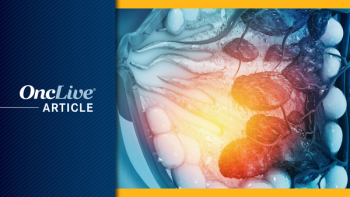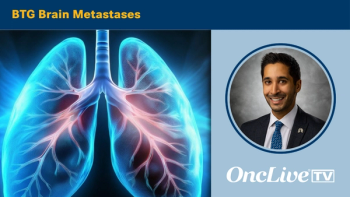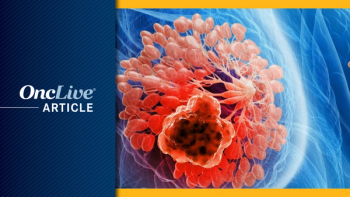
Targeting the ‘New Kids on the Block’ in NSCLC: EGFR Exon 20 and MET Exon 14 Skipping Mutations
Investigators are harnessing comprehensive molecular profiling to detect new targets, optimize existing treatment regimens, and develop novel therapies for patients with EGFR and MET exon 20–insertion positive non–small cell lung cancer.
IInvestigators are harnessing comprehensive molecular profiling to detect new targets, optimize existing treatment regimens, and develop novel therapies for patients with EGFR exon 20–mutant non–small cell lung cancer (NSCLC) and those with a MET exon 14 mutation.
EGFR exon insertions, distinct from ‘classical’ sensitizing mutations, make up 4% to 10% of all EGFR-mutant lung cancer, Catherine A. Shu, MD, associate professor of medicine at Columbia University Medical Center in New York, New York, said in a presentation at the 17th Annual New York Lung Cancers Symposium. These mutations typically appear in never-smokers, female patients, and those of East Asian descent.
Both amivantamab-vmjw (Rybrevant) and mobocertinib (Exkivity) are FDA approved for use in this population. Amivantamab is a dual EGFR-MET antibody that binds to the extracellular portion of EGFR. Mobocertinib is a small molecule EGFR TKI that has been chemically optimized from osimertinib (Tagrisso) to be more selective on exon 20 mutations.
In the pivotal phase 1 CHRYSALIS trial (NCT02609776) of 81 patients who received prior platinum, amivantamab led to an objective response rate (ORR) of 40% per independent review committee (IRC).1 The median duration of response (DOR) was 11.1 months, and the median progression-free survival (PFS) was 8.3 months.
Regarding insertion location, the 1 patient with an exon 20 insertion in the helical region responded to amivantamab. Patients with near loop mutations (n = 54) otherwise derived the highest response rate at 41% vs 25% in those with far loop mutations (n = 8).
Infusion-related reactions were the most common toxicity (any grade, 66%; grade ≥3, 3%), occurring predominantly on the first day of treatment. Dermatologic toxicities included rash (any grade, 86%; grade ≥3, 4%) and paronychia (any grade, 45%), and MET-related events included hypoalbuminemia (27%) and edema (18%). Dose reduction and discontinuation occurred in 13% and 10% of patients, respectively.
“I’ve also noticed a lot of scalp toxicity, which can be kind of ugly. It’s not something that’s really mentioned too much, but it’s something you have to work really closely with dermatologists on at your center,” Shu said.
At the approved dose of 160 mg once daily, mobocertinib led to a confirmed ORR of 28% per IRC in 114 platinum-pretreated patients in a phase 1/2 trial (NCT02716116).2 The median DOR and PFS were 17.5 months (95% CI, 8.3-not evaluable) and 7.3 months (95% CI, 5.5-10.2), respectively.
Primary gastrointestinal toxicities included diarrhea (any grade, 91%; grade >3, 21%), decreased appetite (35%), and nausea (34%). Similar to amivantamab, rash (any grade, 45%) and paronychia (38%) were common dermatologic toxicities. Regarding cardiac toxicity, QTc prolongation occurred in 11% of patients (grade >3, 3%), and cardiac failure led to 1 treatment-related death. Notably, dose reductions and discontinuations were more common, at 25% and 17%, respectively.
“The oral agent may be a little bit easier [to tolerate compared with amivantamab, which is an intravenous infusion,]” Shu said.
Though not yet approved, CLN-081 is a novel, irreversible oral EGFR inhibitor with selectivity for EGFR exon 20 insertions that has shown promising activity. In a phase 1/2 trial (NCT04036682) of 73 patients, the agent led to a confirmed partial response (cPR) rate of 38.4% and a median DOR of 10 months (95% CI, 6-not calculable).3 Three dose levels were studied, showing comparable activity: ≤65 mg (cPR rate, 35%), 100 mg (cPR rate, 41%), and 150 mg (cPR rate, 36.4%) when administered twice daily, and dose reductions and discontinuations were uncommon at doses less than 150 mg.
Across all dose levels, key toxicities included the typical rash (any grade, 80%; grade ≥3, 1%), paronychia (any grade, 32%), diarrhea (any grade, 30%; grade ≥3, 3%), and fatigue (any grade, 21%).
Another agent in the pipeline is sunvozertinib, a novel, oral EGFR exon 20 inhibitor. In a pooled analysis of the WU-KONG 1, 2, and 6 trials, the combined ORR was 52.4% at 300 mg daily (n = 169).4 As with the other 3 agents, common toxicities included diarrhea (any grade, 58%; grade ≥3, 5.5%), rash (any grade, 39.5%; grade ≥3, 1.3%), and paronychia (any grade, 27.7%; grade ≥3, 1.3%).
“In the first line, if I don’t have a clinical trial, I’m going to put people on carboplatin/pemetrexed [Alimta] and maybe bevacizumab [Avastin],” Shu said, stating that prior to enrollment close, the phase 3 PAPILLON trial (NCT04538664) was one she commonly referred patients to.
“Second line, I’m putting people mostly on amivantamab because of the higher response rate although it does mean more inconvenience to the patient with IV infusions. Third line is mobocertinib and then of course, clinical trials,” Shu said.
Next, Shu discussed MET exon 14 skipping mutations, which are found in approximately 3% of patients with NSCLC and are generally more common in older patients, women, and non-smokers. Because of their heterogeneity, Shu advised using RNA-based assays as they detect a higher proportion of MET exon 14 skipping cases compared with DNA-based targeted genotyping panels.
Once a mutation has been identified, providers have the option of selecting between tepotinib (Tepmetko) and capmatinib (Tabrecta). The FDA has approved both agents for use in patients with advanced NSCLC with MET exon 14 skipping mutations based on the pivotal, phase 2 VISION (NCT02864992) and GEOMETRY (NCT02414139) trials, respectively.
In VISION, tepotinib led to a confirmed, IRC-assessed ORR of 46% at 450 mg daily (n = 99).5 The median DOR was 11.1 months (95% CI, 7.2-NE), and the median PFS was 8.5 months (95% CI, 6.7-11). The median overall survival, although not mature, was 17.1 months (95% CI, 12-26.8).
The most common toxicity was peripheral edema (any grade, 63%; grade >3, 7%), although gastrointestinal effects including nausea (any grade, 26%; grade >3, 1%) and diarrhea (any grade, 22%; grade >3, 1%) were also notable. Dose reduction occurred in approximately one-third of patients (33%), and 11% discontinued treatment, primarily due to peripheral edema, pleural effusion, and dyspnea.
In GEOMETRY, capmatinib demonstrated an IRC-assessed ORR of 68% (n = 28) in treatment-naïve patients and 41% (n = 69) in previously treated patients.6 The median DOR and PFS was 12.6 months (95% CI, 5.6-NE) and 12.4 months (95% CI, 8.2-NE) in the treatment-naïve subgroup vs 9.7 months (95% CI, 5.6-13) and 5.4 months (95% CI, 4.2-7) in the previously treated group.
In terms of toxicity, peripheral edema was similarly the most common effect (any grade, 51%; grade >3, 9%). Nausea (any grade, 45%; grade >3, 2%), vomiting (any grade, 28%; grade >3, 2%), and diarrhea (any grade, 18%; grade >3, 1%) were also reported. Dose reduction occurred in 23% of patients; 11% of patients also required treatment discontinuation primarily due to peripheral edema.
“MET inhibition has a unique signature across all drugs. Mostly it’s this peripheral edema that is most concerning to patients,” Shu said.
“What do I do? For me, it’s pretty straightforward. I start with capmatinib or tepotinib, especially in older patients, because that way they don’t have to come in for infusions. Some people prefer tepotinib for its daily dosing. I’ve been giving capmatinib more because that agent was approved first, but both are good drugs,” Shu said. “Second line would be chemoimmunotherapy. Even in a patient with high PD-L1 expression, for me, the value of having that PO drug is so great.”
Shu added that the algorithm may soon change pending further data with amivantamab, which has shown a respectable ORR of 33% (57%) in treatment-naïve patients (n = 7). The median PFS was 6.7 months (95% CI, 2.9-15.3) in a small population of patients with MET exon 14 skipping mutations (n = 46) in the CHRYSALIS study.7
“In terms of the key toxicities, it’s similar to the overall CHRYSALIS cohort, which again includes rash, paronychia, and infusion-related reactions,” Shu concluded.
References
- Park K, Haura EB, Leighl NB, et al. Amivantamab in EGFR exon 20 insertion-mutated non-small-cell lung cancer progressing on platinum chemotherapy: Initial results from the CHRYSALIS phase I study. J Clin Oncol. 2021;39(30):3391-3402. doi:10.1200/JCO.21.00662
- Zhou C, Ramalingam SS, Kim TM, et al. Treatment outcomes and safety of mobocertinib in platinum-pretreated patients with EGFR exon 20 insertion-positive metastatic non-small cell lung cancer: A phase 1/2 open-label nonrandomized clinical trial. JAMA Oncol. 2021;7(12):e214761. doi:10.1001/jamaoncol.2021.4761
- Yu HA, Tan DSW, Smit EF, et al. Phase (Ph) 1/2a study of CLN-081 in patients (pts) with NSCLC with EGFR exon 20 insertion mutations (Ins20). J Clin Oncol. 2022;40(suppl 16): 9007. doi:10.1200/JCO.2022.40.16_suppl.9007
- Shu C. The new kids on the block: EGFR exon 20 and MET exon 14. Presented at: the 17th Annual New York Lung Cancers Symposium; November 12, 2022; New York, New York.
- Paik PK, Felip E, Veillon R, et al. Tepotinib in non-small-cell lung cancer with MET exon 14 skipping mutations. N Engl J Med. 2020;383(10):931-943. doi:10.1056/NEJMoa2004407
- Wolf J, Seto T, Han JY, et al. Capmatinib in MET exon 14-mutated or MET-amplified non-small-cell lung cancer. N Engl J Med. 2020;383(10):944-957. doi:10.10156/NEJMoa2002787
- Krebs M, Spira AI, Cho BC, et al. Amivantamab in patients with NSCLC with MET exon 14 skipping mutation: Updated results from the CHRYSALIS study. J Clin Oncol. 2022;40(suppl 16):9008. doi:10.1200/JCO.2022.40.16_suppl.9008

























































































